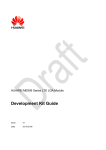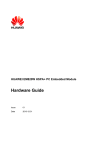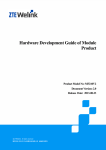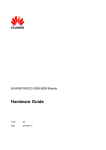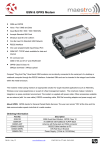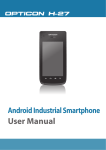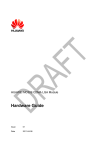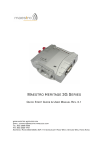Download Huawei ME99 User's Manual
Transcript
HUAWEI ME909 Series Mini PCIe Module Hardware Guide Issue 0.1 Date 2013-06-09 Huawei Technologies Co., Ltd. provides customers with comprehensive technical support and service. For any assistance, please contact our local office or company headquarters. Huawei Technologies Co., Ltd. Huawei Industrial Base, Bantian, Longgang, Shenzhen 518129, People’s Republic of China Tel: +86-755-28780808 Global Hotline: +86-755-28560808 Website: www.huawei.com E-mail: [email protected] Please refer color and shape to product. Huawei reserves the right to make changes or improvements to any of the products without prior notice. Copyright © Huawei Technologies Co., Ltd. 2013. All rights reserved. No part of this document may be reproduced or transmitted in any form or by any means without prior written consent of Huawei Technologies Co., Ltd. The product described in this manual may include copyrighted software of Huawei Technologies Co., Ltd and possible licensors. Customers shall not in any manner reproduce, distribute, modify, decompile, disassemble, decrypt, extract, reverse engineer, lease, assign, or sublicense the said software, unless such restrictions are prohibited by applicable laws or such actions are approved by respective copyright holders under licenses. Trademarks and Permissions , , and are trademarks or registered trademarks of Huawei Technologies Co., Ltd. Other trademarks, product, service and company names mentioned are the property of their respective owners. Notice Some features of the product and its accessories described herein rely on the software installed, capacities and settings of local network, and may not be activated or may be limited by local network operators or network service providers, thus the descriptions herein may not exactly match the product or its accessories you purchase. Huawei Technologies Co., Ltd reserves the right to change or modify any information or specifications contained in this manual without prior notice or obligation. NO WARRANTY THE CONTENTS OF THIS MANUAL ARE PROVIDED “AS IS”. EXCEPT AS REQUIRED BY APPLICABLE LAWS, NO WARRANTIES OF ANY KIND, EITHER EXPRESS OR IMPLIED, INCLUDING BUT NOT LIMITED TO, THE IMPLIED WARRANTIES OF MERCHANTABILITY AND FITNESS FOR A PARTICULAR PURPOSE, ARE MADE IN RELATION TO THE ACCURACY, RELIABILITY OR CONTENTS OF THIS MANUAL. TO THE MAXIMUM EXTENT PERMITTED BY APPLICABLE LAW, IN NO CASE SHALL HUAWEI TECHNOLOGIES CO., LTD BE LIABLE FOR ANY SPECIAL, INCIDENTAL, INDIRECT, OR CONSEQUENTIAL DAMAGES, OR LOST PROFITS, BUSINESS, REVENUE, DATA, GOODWILL OR ANTICIPATED SAVINGS. Import and Export Regulations Customers shall comply with all applicable export or import laws and regulations and will obtain all necessary governmental permits and licenses in order to export, re-export or import the product mentioned in this manual including the software and technical data therein. HUAWEI ME909 Series Mini PCIe Module Hardware Guide About This Document About This Document Revision History Document Version Date 0.1 2013-06-09 Chapter Descriptions Creation This is a draft version, and some chapters are still with "TBD". Issue 0.1 (2013-06-09) Huawei Proprietary and Confidential Copyright © Huawei Technologies Co., Ltd. 3 HUAWEI ME909 Series Mini PCIe Module Hardware Guide Contents Contents 1 Introduction.................................................................................................................................... 7 2 Overall Description ...................................................................................................................... 8 2.1 About This Chapter ........................................................................................................................... 8 2.2 Function Overview............................................................................................................................ 8 2.3 Circuit Block Diagram ....................................................................................................................... 9 3 Description of the Application Interfaces .............................................................................. 10 3.1 About This Chapter ......................................................................................................................... 10 3.2 Mini PCIe Interface ......................................................................................................................... 10 3.3 Power Sources and Grounds ......................................................................................................... 14 3.4 Power Supply Time Sequence ....................................................................................................... 15 3.5 WAKE# Signal ................................................................................................................................ 16 3.6 RESIN_N Signal ............................................................................................................................. 16 3.7 W_DISABLE# Signal ...................................................................................................................... 18 3.8 LED_WWAN# Signal ...................................................................................................................... 18 3.9 USB Interface ................................................................................................................................. 18 3.10 USIM Card Interface .................................................................................................................... 19 3.10.1 Overview .............................................................................................................................. 19 3.10.2 Circuit Recommended for the USIM Card Interface ............................................................ 20 3.11 Audio Interface.............................................................................................................................. 21 3.12 RF Antenna Connector ................................................................................................................. 22 3.13 Reserved Pins .............................................................................................................................. 23 3.14 NC Pins ........................................................................................................................................ 23 4 RF Specifications ......................................................................................................................... 25 4.1 About This Chapter ......................................................................................................................... 25 4.2 Operating Frequencies ................................................................................................................... 25 4.3 Conducted RF Measurement ......................................................................................................... 26 4.3.1 Test Environment ................................................................................................................... 26 4.3.2 Test Standards ....................................................................................................................... 26 4.4 Conducted Rx Sensitivity and Tx Power ........................................................................................ 26 4.4.1 Conducted Receive Sensitivity .............................................................................................. 26 4.4.2 Conducted Transmit Power ................................................................................................... 28 4.5 Antenna Design Requirements ...................................................................................................... 29 Issue 0.1 (2013-06-09) Huawei Proprietary and Confidential Copyright © Huawei Technologies Co., Ltd. 4 HUAWEI ME909 Series Mini PCIe Module Hardware Guide Contents 4.5.1 Antenna Design Indicators..................................................................................................... 29 4.5.2 Interference ........................................................................................................................... 31 4.5.3 GSM/WCDMA/GPS Antenna Requirements ......................................................................... 31 4.5.4 Radio Test Environment ........................................................................................................ 32 5 Electrical and Reliability Features ........................................................................................... 34 5.1 About This Chapter ......................................................................................................................... 34 5.2 Absolute Ratings ............................................................................................................................ 34 5.3 Operating and Storage Temperatures and Humidity ...................................................................... 35 5.4 Electrical Features of USIM ........................................................................................................... 35 5.5 Electrical Features of Application Interfaces .................................................................................. 35 5.6 Power Supply Features .................................................................................................................. 36 5.6.1 Input Power Supply ............................................................................................................... 36 5.6.2 Power Consumption .............................................................................................................. 37 5.7 Reliability Features ......................................................................................................................... 42 5.8 EMC and ESD Features ................................................................................................................. 43 6 Mechanical Specifications ......................................................................................................... 45 6.1 About This Chapter ......................................................................................................................... 45 6.2 Dimensions and Interfaces ............................................................................................................. 45 6.3 Dimensions of the Mini PCI Express Connector ............................................................................ 46 6.4 Specification Selection for Fasteners ............................................................................................. 47 6.4.1 Installing the Mini PCIe Adapter on the Main Board .............................................................. 47 6.4.2 Removing the Mini PCIe Adapter from the Main Board ........................................................ 49 7 Certifications ................................................................................................................................ 51 7.1 About This Chapter ......................................................................................................................... 51 7.2 Certifications ................................................................................................................................... 51 8 Safety Information ...................................................................................................................... 52 8.1 Interference .................................................................................................................................... 52 8.2 Medical Device ............................................................................................................................... 52 8.3 Area with Inflammables and Explosives ......................................................................................... 52 8.4 Traffic Security................................................................................................................................ 53 8.5 Airline Security................................................................................................................................ 53 8.6 Safety of Children ........................................................................................................................... 53 8.7 Environment Protection .................................................................................................................. 53 8.8 WEEE Approval .............................................................................................................................. 53 8.9 RoHS Approval ............................................................................................................................... 53 8.10 Laws and Regulations Observance ............................................................................................. 54 8.11 Care and Maintenance ................................................................................................................. 54 8.12 Emergency Call ............................................................................................................................ 54 8.13 Regulatory Information ................................................................................................................. 54 8.13.1 CE Approval (European Union) ........................................................................................... 54 Issue 0.1 (2013-06-09) Huawei Proprietary and Confidential Copyright © Huawei Technologies Co., Ltd. 5 HUAWEI ME909 Series Mini PCIe Module Hardware Guide Contents 8.13.2 FCC Statement .................................................................................................................... 55 9 Appendix A Circuit of Typical Interface ................................................................................ 56 10 Appendix B Acronyms and Abbreviations .......................................................................... 57 Issue 0.1 (2013-06-09) Huawei Proprietary and Confidential Copyright © Huawei Technologies Co., Ltd. 6 HUAWEI ME909 Series Mini PCIe Module Hardware Guide Introduction 1 Introduction This document describes the hardware application interfaces and air interfaces provided by HUAWEI ME909 Series Mini PCIe Module, including ME909u-521, ME909u-121 and ME909u-721 (hereinafter referred to as the ME909 module). This document helps hardware engineer to understand the interface specifications, electrical features and related product information of the ME909 module. Table 1-1 ME909 series product name Product name Description State ME909u-521 LTE Module for Europe. Under development ME909u-121 LTE Module for North America. Planning ME909u-721 LTE Module for Japan. Planning Issue 0.1 (2013-06-09) Huawei Proprietary and Confidential Copyright © Huawei Technologies Co., Ltd. 7 HUAWEI ME909 Series Mini PCIe Module Hardware Guide 2 Overall Description Overall Description 2.1 About This Chapter This chapter gives a general description of the ME909 module and provides: Function Overview Circuit Block Diagram 2.2 Function Overview Table 2-1 Features Feature Description Physical Dimensions Dimensions (L × W × H): 51 mm × 30.4 mm × 3.35 mm Weight: about 12 g Operating Temperature –20°C to +60°C Storage Temperature –40°C to +85°C Power Voltage DC 3.0 V–3.6 V (typical value is 3.3 V) Application Interface (52-pin Mini PCIe interface One standard USIM (Universal Subscriber Identity Module) card (Class B and Class C) Audio interface: PCM interface USB 2.0 (High Speed) RESIN_N: Reset module WAKE#: Wake up signal W_DISABLE# Signal (the software version is planning.) Issue 0.1 (2013-06-09) Huawei Proprietary and Confidential Copyright © Huawei Technologies Co., Ltd. 8 HUAWEI ME909 Series Mini PCIe Module Hardware Guide Feature Overall Description Description LED_WWAN#: Active-low LED signal indicating the state of the module (the software is under development) Antenna connector WWAN MAIN antenna connector x1 WWAN AUX antenna connector x1 GPS antenna connector x1 2.3 Circuit Block Diagram Figure 2-1 shows the circuit block diagram of the ME909 Mini PCIe Adapter. The major functional unit of the Mini PCIe Adapter contains the following parts: DCDC Circuit LGA Module Control signals Antenna Connectors Figure 2-1 Circuit block diagram of the ME909 module Issue 0.1 (2013-06-09) Huawei Proprietary and Confidential Copyright © Huawei Technologies Co., Ltd. 9 HUAWEI ME909 Series Mini PCIe Module Hardware Guide 3 Description of the Application Interfaces Description of the Application Interfaces 3.1 About This Chapter This chapter mainly describes the external application interfaces of the ME909 module, including: Mini PCIe Interface Power Sources and Grounds Power Supply Time Sequence WAKE# Signal RESIN_N Signal W_DISABLE# Signal LED_WWAN# Signal USB Interface USIM Card Interface Audio Interface RF Antenna Connector Reserved Pins NC Pins 3.2 Mini PCIe Interface The ME909 module uses a Mini-PCIe interface as its external interface. For details about the module and dimensions, see “6.2 Dimensions and Interfaces”. Issue 0.1 (2013-06-09) Huawei Proprietary and Confidential Copyright © Huawei Technologies Co., Ltd. 10 HUAWEI ME909 Series Mini PCIe Module Hardware Guide Description of the Application Interfaces Figure 3-1 shows the sequence of pins on the interface of the Mini PCIe Adapter. Figure 3-1 Sequence of Mini-PCIe interface Table 3-1 shows the pin definitions of the Mini PCIe Interface. Table 3-1 Pin definitions of the Mini PCIe interface PIN No. Pin Name Mini PCI Express Standard Description HUAWEI Pin Description 1 WAKE# WAKE# O 2 3.3Vaux VCC_3V3 3 COEX1 4 I/O Description DC Characteristics (V) Min. Typ. Max. Open collector active low signal. This signal is used to wake up the host. –0.3 - - P 3.3 V DC supply rails from the PC side. 3.0 3.3 3.6 NC - Not connected - - - GND GND - Ground - - - 5 COEX2 NC - Not connected - - - 6 1.5 V NC - Not connected - - - 7 CLKREQ# NC - Not connected - - - Issue 0.1 (2013-06-09) Huawei Proprietary and Confidential Copyright © Huawei Technologies Co., Ltd. 11 HUAWEI ME909 Series Mini PCIe Module Hardware Guide PIN No. Pin Name Mini PCI Express Standard Description HUAWEI Pin Description 8 UIM_PWR UIM_PWR P 9 GND GND 10 UIM_DATA 11 I/O Description of the Application Interfaces Description DC Characteristics (V) Min. Typ. Max. Power source for the external USIM card - 1.8/2.85 - - Ground - - - UIM_DATA I/O External USIM data signal - 1.8/2.85 - REFCLK- NC - Not connected - - - 12 UIM_CLK UIM_CLK O External USIM clock signal - 1.8/2.85 - 13 REFCLK+ NC - Not connected - - - 14 UIM_RESET UIM_RESET O External USIM reset signal - 1.8/2.85 - 15 GND GND - Ground - - - 16 UIM_Vpp NC - Not connected - - - 17 Reserved Reserved - Reserved - - - 18 GND GND - Ground - - - 19 Reserved Reserved - Reserved - - - 20 W_DISABLE# W_DISABLE# - The W_DISABLE# signal is an active low signal that when asserted (driven low) by the system shall disable radio operation. - - - The software version is planning. 21 GND GND - Ground - - - 22 PERST# RESIN_N - Reset module - - - Active-low 23 PERn0 NC - Not connected - - - 24 3.3Vaux VCC_3V3 P 3.3 V DC supply rails from the PC side. 3.0 3.3 3.6 25 PERp0 NC - Not connected - - - Issue 0.1 (2013-06-09) Huawei Proprietary and Confidential Copyright © Huawei Technologies Co., Ltd. 12 HUAWEI ME909 Series Mini PCIe Module Hardware Guide PIN No. Pin Name Mini PCI Express Standard Description HUAWEI Pin Description 26 GND GND - 27 GND GND 28 1.5 V 29 I/O Description of the Application Interfaces Description DC Characteristics (V) Min. Typ. Max. Ground - - - - Ground - - - NC - Not connected - - - GND GND - Ground - - - 30 SMB_CLK NC - Not connected - - - 31 PETn0 NC - Not connected - - - 32 SMB_DATA NC - Not connected - - - 33 PETp0 NC - Not connected - - - 34 GND GND - Ground - - - 35 GND GND - Ground - - - 36 USB_D- USB_DM I/O USB signal D- - - - 37 GND GND - Ground - - - 38 USB_D+ USB_DP I/O USB signal D+ - - - 39 3.3Vaux VCC_3V3 P 3.3 V DC supply rails from the PC side. 3.0 3.3 3.6 40 GND GND - Ground - - - 41 3.3Vaux VCC_3V3 P 3.3 V DC supply rails from the PC side 3.0 3.3 3.6 42 LED_WWAN# LED_WWAN# O Active-low LED signal indicating the state of the card. - - - The software feature is under development and don't support this function now. Drive strength: 10 mA 43 GND GND - Ground - - - 44 LED_WLAN# NC - Not connected - - - 45 Reserved PCM_CLK O PCM interface clock –0.3 1.8 2.1 Issue 0.1 (2013-06-09) Huawei Proprietary and Confidential Copyright © Huawei Technologies Co., Ltd. 13 HUAWEI ME909 Series Mini PCIe Module Hardware Guide PIN No. Pin Name Mini PCI Express Standard Description HUAWEI Pin Description 46 LED_WPAN# NC - 47 Reserved PCM_DOUT 48 1.5 V 49 I/O Description of the Application Interfaces Description DC Characteristics (V) Min. Typ. Max. Not connected - - - O PCM I/F data out –0.3 1.8 2.1 NC - Not connected - - - Reserved PCM_DIN I PCM I/F data in –0.3 1.8 2.1 50 GND GND - Ground - - - 51 Reserved PCM_SYNC O PCM interface sync –0.3 1.8 2.1 52 3.3Vaux VCC_3V3 P 3.3 V DC supply rail from the PC side. 3.0 3.3 3.6 P indicates power pins; I indicates pins for digital signal input; O indicates pins for digital signal output. AI indicates pins for analog signal input. The Reserved pins are internally connected to the module. Therefore, these pins should not be used, otherwise they may cause problems. Please contact with us for more details about this information. The NC (Not Connected) pins are floating and there are no signal connected to these pins. Therefore, these pins should not be used. 3.3 Power Sources and Grounds For the Mini PCIe Adapter, +3.3 Vaux is the only voltage supply that is available. The input voltage is 3.3 V±9%, as specified by PCI Express Mini CEM Specifications 1.2. Table 3-2 Power and ground specifications Pin No. Pin Name Minimum Typical Maximum 2, 24, 39, 41 and 52 VCC_3V3 3.0 V 3.3 V 3.6 V 4, 9, 15, 18, 21, 26, 27, 29, 34, 35, 37, 40, 43, and 50 GND - To minimize the RF radiation through the power lines, it is suggested to add ceramic capacitors of 10 pF and 100 nF in the power lines beside the Mini PCIe connector on the host side. Issue 0.1 (2013-06-09) Huawei Proprietary and Confidential Copyright © Huawei Technologies Co., Ltd. 14 HUAWEI ME909 Series Mini PCIe Module Hardware Guide Description of the Application Interfaces 3.4 Power Supply Time Sequence Power on sequence Do not toggle RESIN_N pin during the power on sequence. Pulling RESIN_N pin low will extend time for module startup. Figure 3-2 Power on timing sequence Parameter Remarks Time (Nominal value) Unit TPD+ Power Valid to USB D+ high 14 s Power off Sequence Cutting off 3.3 V will power off the module. Figure 3-3 Power off timing sequence Issue 0.1 (2013-06-09) Huawei Proprietary and Confidential Copyright © Huawei Technologies Co., Ltd. 15 HUAWEI ME909 Series Mini PCIe Module Hardware Guide Description of the Application Interfaces 3.5 WAKE# Signal WAKE# pin (the signal that the module uses to wake up the PC) supports software control. This signal is used for module to wake up the host. It is designed as an OC gate, so it should be pulled up by the host and it is active-low. When the module wakes up the host, the BB Chip hold 1s high-level-voltage pulse and then module output low-level-voltage to wake the host. Figure 3-4 Connections of the WAKE# pin 3.6 RESIN_N Signal The RESIN_N pin is used to reset the module's system. When the module software stops responding, the RESIN_N pin can be pulled down to reset the module hardware. The RESIN_N signal is internally pulled up to 1.8 V, which is automatically on when 3.3 V is applied and it is active-low. Issue 0.1 (2013-06-09) Huawei Proprietary and Confidential Copyright © Huawei Technologies Co., Ltd. 16 HUAWEI ME909 Series Mini PCIe Module Hardware Guide Description of the Application Interfaces Figure 3-5 Connections of the RESIN_N pin As the RESIN_N signal are relatively sensitive, it is recommended that you install a 10 nF to 0.1 µF capacitor near the RESIN_N pin of the interface for filtering. In addition, when you design a circuit on the PCB of the interface board, it is recommended that the circuit length should not exceed 20 mm and that the circuit should be kept at a distance of 2.54 mm (100 mil) at least from the PCB edge. Furthermore, you need to wrap the area adjacent to the signal wire with a ground wire. Otherwise, the module may be reset due to interference. The ME909 module supports hardware reset function. If the software of the ME909 module stops responding, you can reset the hardware through the RESIN_N signal as shown inFigure 3-6 . When a low-level pulse is supplied through the RESIN_N pin, the hardware will be reset. After the hardware is reset, the software starts powering on the module and reports relevant information according to the actual settings. For example, the AT command automatically reports ^SYSSTART. Figure 3-6 Reset pulse timing The RESIN_N pin must not be pulled down for more than 1s. The RESIN_N pin is optional, which can be not connected. The maximum Forward Voltage Drop of the diode used in the module is 0.6 V. Issue 0.1 (2013-06-09) Huawei Proprietary and Confidential Copyright © Huawei Technologies Co., Ltd. 17 HUAWEI ME909 Series Mini PCIe Module Hardware Guide Description of the Application Interfaces 3.7 W_DISABLE# Signal The W_DISABLE# signal is provided to allow users to disable wireless communications of the module. The software version is planning. 3.8 LED_WWAN# Signal ME909 provides a LED_WWAN# signal to indicate the RF status. The ME909 module does not support this function because the software feature is under development. The planning drive strength is10 mA. External Circuits igure 3-7 shows the recommended circuits of the LED_WWAN# pin. According to F LED feature, you can adjust the LED brightness by adjusting the resistance of resistor R. Figure 3-7 Driving circuit 3.9 USB Interface The ME909 module is compliant with USB 2.0 protocol. The USB interface is powered directly from the VBAT supply. The USB input/output lines are compatible with the USB 2.0 signal specifications. Figure 3-8 shows the circuit of the USB interface. Issue 0.1 (2013-06-09) Huawei Proprietary and Confidential Copyright © Huawei Technologies Co., Ltd. 18 HUAWEI ME909 Series Mini PCIe Module Hardware Guide Description of the Application Interfaces Table 3-3 Definition of the USB interface Pin No. Pin Name I/O Description DC Characteristics (V) Min. Typ. Max. 36 USB_DM I/O USB signal D- - - - 38 USB_DP I/O USB signal D+ - - - According to USB protocol, for bus timing or electrical characteristics of ME909 USB signal, please refer to the chapter 7.3.2 of Universal Serial Bus Specification 2.0. Figure 3-8 Recommended circuit of USB interface 3.10 USIM Card Interface 3.10.1 Overview The ME909 module provides a USIM card interface complying with the ISO 7816-3 standard and supports both Class B and Class C USIM cards. Table 3-4 USIM card interface signals Pin No. Pin Name 14 UIM_RESET O 12 UIM_CLK 10 UIM_DATA Issue 0.1 (2013-06-09) I/O Description DC Characteristics (V) Min. Typ. External USIM reset signal. - 1.8/2.85 O External USIM clock signal - 1.8/2.85 I/O External USIM data signal - 1.8/2.85 Huawei Proprietary and Confidential Copyright © Huawei Technologies Co., Ltd. Max. - 19 HUAWEI ME909 Series Mini PCIe Module Hardware Guide Pin No. Pin Name 8 UIM_PWR I/O P Description of the Application Interfaces Description Power source for the external USIM card DC Characteristics (V) Min. Typ. Max. - 1.8/2.85 - 3.10.2 Circuit Recommended for the USIM Card Interface As the Mini PCIe Adapter is not equipped with an USIM socket, you need to place an USIM socket on the user interface board. Figure 3-9 shows the circuit of the USIM card interface. Figure 3-9 Circuit of the USIM card interface Issue 0.1 (2013-06-09) Huawei Proprietary and Confidential Copyright © Huawei Technologies Co., Ltd. 20 HUAWEI ME909 Series Mini PCIe Module Hardware Guide Description of the Application Interfaces To meet the requirements of 3GPP TS 51.010-1 protocols and electromagnetic compatibility (EMC) authentication, the USIM socket should be placed near the PCIe interface (it is recommended that the PCB circuit connects the PCIe interface and the USIM socket does not exceed 100 mm), because a long circuit may lead to wave distortion, thus affecting signal quality. It is recommended that you wrap the area adjacent to the UIM_CLK and UIM_DATA signal wires with ground. The Ground pin of the USIM socket and the Ground pin of the USIM card must be well connected to the power Ground pin supplying power to the PCIe Adapter. A 100 nF capacitor and1 μF capacitor are placed between the UIM_PWR and GND pins in a parallel manner (If UIM_PWR circuit is too long, that the larger capacitance such as 4.7 μF can be employed if necessary). Three 33 pF capacitors are placed between the UIM_DATA and Ground pins, the UIM_RESET and Ground pins, and the UIM_CLK and Ground pins in parallel to filter interference from RF signals. It is recommended to take electrostatic discharge (ESD) protection measures near the USIM card socket. The TVS diode with Vrwm of 5 V and junction capacitance less than 10 pF must be placed as close as possible to the USIM socket, and the Ground pin of the ESD protection component is well connected to the power Ground pin that supplies power to the PCIe Adapter. 3.11 Audio Interface The ME909 module provides one PCM digital audio interface. Table 3-5 lists the signals on the digital audio interface. The software feature of PCM is planning. Table 3-5 Signals on the digital audio interface Pin No. Pin Name 45 PCM_CLK O 49 PCM_DIN 51 47 I/O Description DC Characteristics (V) Min. Typ. Max. PCM clock –0.3 1.8 2.1 I PCM data input –0.3 1.8 2.1 PCM_SYNC O PCM interface sync –0.3 1.8 2.1 PCM_DOUT O PCM data output –0.3 1.8 2.1 The ME909 module interface enables communication with an external codec to support linear format. Issue 0.1 (2013-06-09) Huawei Proprietary and Confidential Copyright © Huawei Technologies Co., Ltd. 21 HUAWEI ME909 Series Mini PCIe Module Hardware Guide Description of the Application Interfaces Figure 3-10 Circuit diagram of the interface of the PCM (ME909 module is used as PCM master) PCM_SYNC: Output when PCM is in master mode; PCM_CLK: Output when PCM is in master mode; The PCM function of ME909 only supports master mode; It is recommended that a TVS be used on the related interface, to prevent electrostatic discharge and protect integrated circuit (IC) components. 3.12 RF Antenna Connector The ME909 module provides three antenna connectors (MAIN, GPS and AUX) for connecting the external antennas. Issue 0.1 (2013-06-09) Huawei Proprietary and Confidential Copyright © Huawei Technologies Co., Ltd. 22 HUAWEI ME909 Series Mini PCIe Module Hardware Guide Description of the Application Interfaces Figure 3-11 RF antenna connectors AUX GPS MAIN The antenna connectors must be used with coaxial cables with characteristic impedance of 50Ω. 3.13 Reserved Pins The ME909 module provides 2 reserved pins. All of reserved pins cannot be used by the customer. Table 3-6 Reserved pins Pin No. Pin Name I/O Description 17, 19 Reserved - Reserved, please keep open. 3.14 NC Pins The ME909 module has 17 NC pins. All of NC pins should not be connected. Please keep these pins open. Issue 0.1 (2013-06-09) Huawei Proprietary and Confidential Copyright © Huawei Technologies Co., Ltd. 23 HUAWEI ME909 Series Mini PCIe Module Hardware Guide Description of the Application Interfaces Table 3-7 NC pins Pin No. Pin Name I/O Description 3, 5–7, 11, 13, 16, 23, 25, 28, 30–33, 44, 46, 48 NC - Not connected, please keep open. Issue 0.1 (2013-06-09) Huawei Proprietary and Confidential Copyright © Huawei Technologies Co., Ltd. 24 HUAWEI ME909 Series Mini PCIe Module Hardware Guide RF Specifications 4 RF Specifications 4.1 About This Chapter This chapter describes the RF specifications of the ME909 module, including: Operating Frequencies Conducted RF Measurement Conducted Rx Sensitivity and Tx Power Antenna Design Requirements 4.2 Operating Frequencies Table 4-1 shows the RF bands supported by the ME909u-521 module. Table 4-1 RF bands of ME909u-521 Operating Band Tx Rx UMTS Band I 1920 MHz–1980 MHz 2110 MHz–2170 MHz UMTS Band II 1850 MHz–1910 MHz 1930 MHz–1990 MHz UMTS Band V 824 MHz–849 MHz 869 MHz–894 MHz UMTS Band VIII 880 MHz–915 MHz 925 MHz–960 MHz GSM 850 824 MHz–849 MHz 869 MHz–894 MHz GSM 900 880 MHz–915 MHz 925 MHz–960 MHz GSM 1800(DCS) 1710 MHz–1785 MHz 1805 MHz–1880 MHz GSM 1900(PCS) 1850 MHz–1910 MHz 1930 MHz–1990 MHz LTE Band I 1920 MHz–1980 MHz 2110 MHz–2170 MHz LTE Band II 1850 MHz–1910 MHz 1930 MHz–1990 MHz LTE Band III 1710 MHz–1785 MHz 1805 MHz–1880 MHz Issue 0.1 (2013-06-09) Huawei Proprietary and Confidential Copyright © Huawei Technologies Co., Ltd. 25 HUAWEI ME909 Series Mini PCIe Module Hardware Guide RF Specifications Operating Band Tx Rx LTE Band V 824 MHz–849 MHz 869 MHz–894 MHz LTE Band VIII 880 MHz–915 MHz 925 MHz–960 MHz LTE Band VII 2500 MHz–2570 MHz 2620 MHz–2690 MHz LTE Band XX 832 MHz–862 MHz 791 MHz–821 MHz GPS L1 - 1574.42 MHz–1576.42 MHz GLONASS - 1597.55 MHz–1605.89 MHz 4.3 Conducted RF Measurement 4.3.1 Test Environment Test instrument R&S CMU200, R&S CMW500 ,Agilent E5515C Power supply Keithley 2303, Agilent 66319 RF cable for testing L08-C014-350 of DRAKA COMTEQ or Rosenberger Cable length: 29 cm The compensation for different frequency bands relates to the cable and the test environment. The instrument compensation needs to be set according to the actual cable conditions. 4.3.2 Test Standards Huawei modules meet 3GPP TS 51.010-1, 3GPP TS 34.121-1 and 3GPP TS 36.521-1 test standards. Each module passes strict tests at the factory and thus the quality of the modules is guaranteed. 4.4 Conducted Rx Sensitivity and Tx Power 4.4.1 Conducted Receive Sensitivity The conducted receive sensitivity is a key parameter that indicates the receiver performance of ME909u-521 module. The conducted receive sensitivity refers to the weakest signal that the module at the antenna port can receive. The BER must meet the 3GPP protocol requirements in the case of the minimum signal. Issue 0.1 (2013-06-09) Huawei Proprietary and Confidential Copyright © Huawei Technologies Co., Ltd. 26 HUAWEI ME909 Series Mini PCIe Module Hardware Guide RF Specifications The 3GPP Protocol Claim column in Table 4-2 lists the required minimum values, and the Test Value column lists the tested values of the ME909u-521 module. Table 4-2 ME909u-521 module conducted Rx sensitivity (Unit: dBm) Band Typical GSM 850 TBD GSM 900 TBD DCS1800 TBD PCS 1900 TBD WCDMA B1 Main Rx TBD WCDMA B2 Main Rx TBD WCDMA B5 Main Rx TBD WCDMA B8 Main Rx TBD LTE B1 RX TBD LTE B2 RX TBD LTE B3 RX TBD LTE B5 RX TBD LTE B7 RX TBD LTE B8 RX TBD LTE B20 RX TBD Note Table 4-3 ME909u-521 module GPS main characteristics Item Type Value Receive Sensitivity (Cold start) TBD Receive Sensitivity (Hot start) TBD Receive Sensitivity (Tracking mode) TBD TTFF@-130dBm (Cold start) TBD TTFF@-130dBm (Hot start) TBD The test values are the average of some test samples. Issue 0.1 (2013-06-09) Huawei Proprietary and Confidential Copyright © Huawei Technologies Co., Ltd. 27 HUAWEI ME909 Series Mini PCIe Module Hardware Guide RF Specifications 4.4.2 Conducted Transmit Power The conducted transmit power is another indicator that measures the performance of ME909u-521 module. The conducted transmit power refers to the maximum power that the module tested at the antenna connector can transmit. According to the 3GPP protocol, the required transmit power varies with the power class. able 4-4 lists the required ranges of the conducted transmit power of the T ME909u-521 module. The tested values listed in the Test Value column must range from the minimum power to the maximum power. Table 4-4 ME909u-521 module conducted Tx power (unit: dBm) Band Typical GSM 850 TBD GSM 900 TBD DCS1800 TBD PCS 1900 TBD WCDMA B1 TBD WCDMA B2 TBD WCDMA B5 TBD WCDMA B8 TBD LTE B1 RX TBD LTE B2 RX TBD LTE B3 RX TBD LTE B5 RX TBD LTE B7 RX TBD LTE B8 RX TBD LTE B20 RX TBD Note Maximum Power Reduction (MPR) of LTE is according to 3GPP TS 36.521-1 as below. Modulation RB Allocation MPR(dB) QPSK ≥ 1 RB, ≤ Partial RB 0 QPSK > Partial RB ≤1 16QAM ≥ 1 RB, ≤ Partial RB ≤1 16QAM > Partial RB ≤2 Issue 0.1 (2013-06-09) Huawei Proprietary and Confidential Copyright © Huawei Technologies Co., Ltd. 28 HUAWEI ME909 Series Mini PCIe Module Hardware Guide RF Specifications 4.5 Antenna Design Requirements 4.5.1 Antenna Design Indicators Antenna Efficiency Antenna efficiency is the ratio of the input power to the radiated or received power of an antenna. The radiated power of an antenna is always lower than the input power due to the following antenna losses: return loss, material loss, and coupling loss. The efficiency of an antenna relates to its electrical dimensions. To be specific, the antenna efficiency increases with the electrical dimensions. In addition, the transmission cable from the antenna connector of PCIe Adapter to the antenna is also part of the antenna. The cable loss increases with the cable length and the frequency. It is recommended that the cable loss is as low as possible, for example, MXHP32HP1000 made by Murata or equivalent. The following antenna efficiency (free space) is recommended for ME909 module to ensure high radio performance of the module: Efficiency of the primary antenna: ≥ 40% (below 960 MHz); ≥ 50% (over 1710 MHz) Efficiency of the diversity antenna: ≥ half of the efficiency of the primary antenna in receiving band Efficiency of the GPS antenna: ≥ 50% In addition, the efficiency should be tested with the transmission cable. S11 or VSWR S11 indicates the degree to which the input impedance of an antenna matches the reference impedance (50 Ω). S11 shows the resonance feature and impedance bandwidth of an antenna. Voltage standing wave ratio (VSWR) is another expression of S11. S11 relates to the antenna efficiency. S11 can be measured with a vector analyzer. The following S11 value is recommended for the antenna of ME909 module: S11 of the primary antenna: ≤ –6 dB S11 of the diversity antenna: ≤ –6 dB S11 of the GPS antenna: ≤ –10 dB In addition, S11 is less important than the efficiency, and S11 has weak correlation to wireless performance. Isolation For a wireless device with multiple antennas, the power of different antennas is coupled with each other. Antenna isolation is used to measure the power coupling. The power radiated by an antenna might be received by an adjacent antenna, which decreases the antenna radiation efficiency and affects the running of other devices. To avoid this problem, evaluate the antenna isolation as sufficiently as possible at the early stage of antenna design. Antenna isolation depends on the following factors: Issue 0.1 (2013-06-09) Huawei Proprietary and Confidential Copyright © Huawei Technologies Co., Ltd. 29 HUAWEI ME909 Series Mini PCIe Module Hardware Guide Distance between antennas Antenna type Antenna direction RF Specifications The primary antenna must be placed as near as possible to the ME909 module to minimize the cable length. The diversity antenna needs to be installed perpendicularly to the primary antenna. The diversity antenna can be placed farther away from the ME909 module. Antenna isolation can be measured with a two-port vector network analyzer. The following antenna isolation is recommended for the antennas on laptops: Isolation between the primary and diversity antennas: ≤ –12 dB Isolation between the primary(diversity) antenna and the GPS antenna: ≤ –15 dB Isolation between the primary antenna and the Wi-Fi antenna: ≤ –15 dB Polarization The polarization of an antenna is the orientation of the electric field vector that rotates with time in the direction of maximum radiation. The linear polarization is recommended for the antenna of ME909 module. Radiation Pattern The radiation pattern of an antenna reflects the radiation features of the antenna in the remote field region. The radiation pattern of an antenna commonly describes the power or field strength of the radiated electromagnetic waves in various directions fromtheantenna.Thepowerorfieldstrengthvarieswiththeangularcoordinates(θ andφ),butisindependentoftheradial coordinates. The radiation pattern of half wave dipole antennas is omnidirectional in the horizontal plane, and the incident waves of base stations are often in the horizontal plane. For this reason, the receiving performance is optimal. The following radiation patterns are recommended for the antenna of ME909 module. Primary/Diversity/GPS antenna: omnidirectional In addition, the diversityantenna’s pattern should be complementary with the primary’s. Envelope Correlation Coefficient The envelope correlation coefficient indicates the correlation between different antennas in a multi-antenna system (primary antenna, diversity antenna, and MIMO antenna). The correlation coefficient shows the similarity of radiation patterns, that is, amplitude and phase, of the antennas. The ideal correlation coefficient of a diversity antenna system or a MIMO antenna system is 0. A small value of the envelope correlation coefficient between the primary antenna and the diversity antenna indicates a high diversity gain. The envelope correlation coefficient depends on the following factors: Distance between antennas Antenna type Issue 0.1 (2013-06-09) Huawei Proprietary and Confidential Copyright © Huawei Technologies Co., Ltd. 30 HUAWEI ME909 Series Mini PCIe Module Hardware Guide RF Specifications Antenna direction The antenna correlation coefficient differs from the antenna isolation. Sufficient antenna isolation does not represent a satisfactory correlation coefficient. For this reason, the two indicators need to be evaluated separately. For the antennas on laptops, the recommended envelope correlation coefficient between the primary antenna and the diversity antenna is smaller than 0.5. Gain and Directivity The radiation pattern of an antenna represents the field strength of the radiated electromagnetic waves in all directions, but not the power density that the antenna radiates in the specific direction. The directivity of an antenna, however, measures the power density that the antenna radiates. Gain, as another important parameter of antennas, correlates closely to the directivity. The gain of an antenna takes both the directivity and the efficiency of the antenna into account. The appropriate antenna gain prolongs the service life of relevant batteries. The following antenna gain is recommended for ME909 module. Gain of the primary/diversity antenna ≤ 2.5 dBi The antenna consists of the antenna body and the relevant RF transmission cable. Take the RF transmission cable into account when measuring any of the preceding antenna indicators. Huawei cooperates with various famous antenna suppliers who are able to make suggestions on antenna design, for example, Amphenol, Skycross, etc. 4.5.2 Interference Besides the antenna performance, the interference on the user board also affects the radio performance (especially the TIS) of the module. To guarantee high performance of the module, the interference sources on the user board must be properly controlled. On the user board, there are various interference sources, such as the LCD, CPU, audio circuits, and power supply. All the interference sources emit interference signals that affect the normal operation of the module. For example, the module sensitivity can be decreased due to interference signals. Therefore, during the design, you need to consider how to reduce the effects of interference sources on the module. You can take the following measures: Use an LCD with optimized performance; shield the LCD interference signals; shield the signal cable of the board; or design filter circuits. Huawei is able to make technical suggestions on radio performance improvement of the module. 4.5.3 GSM/WCDMA/GPS Antenna Requirements The antenna for ME909 module must fulfill the following requirements: Issue 0.1 (2013-06-09) Huawei Proprietary and Confidential Copyright © Huawei Technologies Co., Ltd. 31 HUAWEI ME909 Series Mini PCIe Module Hardware Guide RF Specifications Antenna Requirements Frequency range Depending on frequency band(s) provided by the network operator, the customer must use the most suitable antenna for that/those band(s) Bandwidth of main antenna 70 MHz in GSM850 80 MHz in GSM900 170 MHz in DCS 140 MHz in PCS 250 MHz in WCDMA /LTE Band 1 140 MHz in WCDMA/LTE Band 2 70 MHz in WCDMA/LTE Band 5 80 MHz in WCDMA/LTE Band 8 170 MHz in LTE Band 3 190 MHz in LTE Band 7 71 MHz in LTE Band 20 Bandwidth of diversity antenna 25 MHz in GSM850 35 MHz in GSM900 75 MHz in DCS 60 MHz in PCS 60 MHz in WCDMA/LTE Band 1 60 MHz in WCDMA/LTE Band 2 25 MHz in WCDMA/LTE Band 5 35 MHz in WCDMA/LTE Band 8 75 MHz in LTE Band 3 70 MHz in LTE Band 7 30 MHz in LTE Band 20 35 MHz in GNSS Gain ≤ 2.5 dBi Impedance 50 Ω VSWR absolute max ≤ 3:1(≤2:1 for GPS antenna) VSWR recommended ≤ 2:1(≤1.5:1 for GPS antenna) 4.5.4 Radio Test Environment The antenna efficiency, antenna gain, radiation pattern, total radiated power (TRP), and TIS can be tested in a microwave testing chamber. Huawei has a complete set of OTA test environments (SATIMO microwave testing chambers and ETS microwave testing chambers). The testing chambers are certified by professional organizations and are applicable to testing at frequencies ranging from 380 MHz to 6 GHz. The test items are described as follows: Issue 0.1 (2013-06-09) Huawei Proprietary and Confidential Copyright © Huawei Technologies Co., Ltd. 32 HUAWEI ME909 Series Mini PCIe Module Hardware Guide RF Specifications Passive Tests Antenna efficiency Gain Pattern shape Envelope correlation coefficient TRP: GSM, WCDMA, CDMA, TD-SCDMA, and LTE systems TIS: GSM, WCDMA, CDMA, TD-SCDMA, and LTE systems Active Tests Figure 4-1 shows the SATIMO microwave testing chamber. Figure 4-1 SATIMO microwave testing chamber Issue 0.1 (2013-06-09) Huawei Proprietary and Confidential Copyright © Huawei Technologies Co., Ltd. 33 HUAWEI ME909 Series Mini PCIe Module Hardware Guide 5 Electrical and Reliability Features Electrical and Reliability Features 5.1 About This Chapter This chapter describes the electrical and reliability features of the interfaces in the ME909 module, including: Absolute Ratings Operating and Storage Temperatures and Humidity Electrical Features of USIM Power Supply Features Reliability Features EMC and ESD Features 5.2 Absolute Ratings able 5-1 lists the absolute ratings for the ME909 module. Using the module beyond T these conditions may result in permanent damage to the module. Table 5-1 Absolute ratings for the ME909 module Symbol Specification Min. Max. Unit VCC_3V3 External power voltage –0.3 4.0 V VI Digital input voltage –0.3 2.16 V Issue 0.1 (2013-06-09) Huawei Proprietary and Confidential Copyright © Huawei Technologies Co., Ltd. 34 HUAWEI ME909 Series Mini PCIe Module Hardware Guide Electrical and Reliability Features 5.3 Operating and Storage Temperatures and Humidity able 5-2 lists the operating and storage temperatures and humidity for the ME909 T module. Table 5-2 Operating and storage temperatures and humidity for the ME909 module Specification Min. Max. Unit Normal working temperatures[1] –20 +60 °C Ambient temperature for storage –40 +85 °C [1]: When the ME909 module works at this temperature, all its RF indexes comply with the 3GPP TS 45.005 and 3GPP TS 34.121-1 specifications. 5.4 Electrical Features of USIM Table 5-3 Electrical features of Digital Pins in the I/O supply domain of the USIM Interface Parameter Description Minimum Value Maximum Value Unit VIH Logic high-level input voltage 0.65 x VDD_PX VDD_PX + 0.3 V VIL Logic low-level input voltage –0.3 0.35 x VDD_PX V VOH Logic high-level output voltage VDD_PX–0.45 VDD_PX V VOL Logic low-level output voltage 0 0.45 V 5.5 Electrical Features of Application Interfaces Table 5-4 lists electrical features (typical values). Table 5-4 Electrical features of application interfaces Parameter Description Minimum Value Maximum Value Unit VIH Logic high-level input voltage 0.65 x VDD_PX VDD_PX + 0.3 V Issue 0.1 (2013-06-09) Huawei Proprietary and Confidential Copyright © Huawei Technologies Co., Ltd. 35 HUAWEI ME909 Series Mini PCIe Module Hardware Guide Electrical and Reliability Features Parameter Description Minimum Value Maximum Value Unit VIL Logic low-level input voltage –0.3 0.35 x VDD_PX V VOH Logic high-level output voltage VDD_PX–0.45 VDD_PX V VOL Logic low-level output voltage 0 0.45 V 5.6 Power Supply Features 5.6.1 Input Power Supply Table 5-5 lists the requirements for input power of the ME909 module. Table 5-5 Requirements for input power for the ME909 module Parameter Min. Typ. Max. Ripple Unit VCC_3V3 3.0 3.3 3.6 0.05 V Figure 5-1 Power Supply During Burst Emission The VCC_3V3 minimum value must be guaranteed during the burst (with 2.7 A Peak in GSM 2 slot mode). So A low-dropout (LDO) regulator or switch power with current output of more than 3.5 A is strongly recommended for external power supply. Table 5-6 Requirements for input current of the ME909 module Power Module Peak (GSM 2 slot) Normal (WCDMA) Normal (LTE 23dbm) VCC_3V3 ME909 2750 mA 1100mA 1200 mA Issue 0.1 (2013-06-09) Huawei Proprietary and Confidential Copyright © Huawei Technologies Co., Ltd. 36 HUAWEI ME909 Series Mini PCIe Module Hardware Guide Electrical and Reliability Features 5.6.2 Power Consumption The power consumptions of ME909 module in different scenarios are respectively listed in Table 5-7 , Table 5-8 , Table 5-9 and Table 5-10 . The power consumption listed in this section is tested when the power supply of the ME909 module is 3.3 V. Typical values are measured at room temperature, and minimum and maximum values are measured over the entire operating temperature range. Table 5-7 Averaged standby DC power consumption Description Bands Test Value Units Notes/Configuration LTE LTE bands TBD mA DRX cycle=8 (2.56 s) (Standby) Module is registered on and not connected to the 4G network. USB is in suspend mode. HSPA+/WCDMA (Standby) UMTS bands TBD mA DRX cycle=8 (2.56 s) Module is registered on and not connected to the 3G network. USB is in suspend mode. GSM/ GPRS/EDGE GSM bands TBD mA MFRMS=5 (1.175 s) Module is registered on and not connected to the 2G network. (Standby) USB is in suspend mode. LTE (Idle) LTE bands TBD mA Module is powered up and idle DRX cycle=8 (2.56 s) Module is registered on the 4G network, and PDP is activated, No data transmission. USB is not in suspend mode. Issue 0.1 (2013-06-09) Huawei Proprietary and Confidential Copyright © Huawei Technologies Co., Ltd. 37 HUAWEI ME909 Series Mini PCIe Module Hardware Guide Electrical and Reliability Features Description Bands Test Value Units Notes/Configuration HSPA+/WCDMA UMTS bands TBD mA Module is powered up and idle (Idle) DRX cycle=8 (2.56 s) Module is registered on the 3G network, and PDP is activated, No data transmission. USB is not in suspend mode. GSM/ GPRS/EDGE GSM bands TBD mA Module power up and idle MFRMS=5 (1.175 s) (Idle) Module is registered on the 2G network, and PDP is activated, No data transmission. USB is not in suspend mode. Radio Off Any band TBD mA Flight mode USB is in suspend mode. Table 5-8 DC power consumption of ME909u-521(WCDMA/HSDPA/LTE) Description Band Test Value Units Power (dBm) WCDMA Band I (IMT2100) TBD mA 1 dBm Tx Power TBD 23.5 dBm Tx Power TBD (PCS 1900) TBD 10 dBm Tx Power TBD 23.5 dBm Tx Power (850 MHz) Issue 0.1 (2013-06-09) 10 dBm Tx Power Band II Band V HSDPA TBD TBD mA mA 1 dBm Tx Power 1 dBm Tx Power TBD 10 dBm Tx Power TBD 23.5 dBm Tx Power Band VIII TBD (900 MHz) TBD 10 dBm Tx Power TBD 23.5 dBm Tx Power Band I TBD mA mA Huawei Proprietary and Confidential Copyright © Huawei Technologies Co., Ltd. 1 dBm Tx Power 1 dBm Tx Power 38 HUAWEI ME909 Series Mini PCIe Module Hardware Guide Description LTE Electrical and Reliability Features Band Test Value Units (IMT2100) TBD 10 dBm Tx Power TBD 23.5 dBm Tx Power mA Band II TBD (PCS 1900) TBD 10 dBm Tx Power TBD 23.5 dBm Tx Power mA 1 dBm Tx Power Band V TBD (850 MHz) TBD 10 dBm Tx Power TBD 23.5 dBm Tx Power TBD (900 MHz) TBD 10 dBm Tx Power TBD 23.5 dBm Tx Power LTE Band I LTE Band III LTE Band V LTE Band VIII LTE Band VII TBD mA 1 dBm Tx Power Band VIII LTE Band II mA 1 dBm Tx Power 1 dBm Tx Power TBD 10 dBm Tx Power TBD 23dBm Tx Power TBD mA 1 dBm Tx Power TBD 10 dBm Tx Power TBD 23 dBm Tx Power TBD mA 1 dBm Tx Power TBD 10 dBm Tx Power TBD 23 dBm Tx Power TBD mA 1 dBm Tx Power TBD 10 dBm Tx Power TBD 23 dBm Tx Power TBD mA 1 dBm Tx Power TBD 10 dBm Tx Power TBD 23 dBm Tx Power TBD mA TBD Issue 0.1 (2013-06-09) Power (dBm) Huawei Proprietary and Confidential Copyright © Huawei Technologies Co., Ltd. 1 dBm Tx Power 10 dBm Tx Power 39 HUAWEI ME909 Series Mini PCIe Module Hardware Guide Description Band Electrical and Reliability Features Test Value Units TBD LTE Band XX TBD Power (dBm) 23 dBm Tx Power mA 1 dBm Tx Power TBD 10 dBm Tx Power TBD 23 dBm Tx Power Table 5-9 DC power consumption of ME909u-521 (GPRS/EDGE) Description Test Value Units PCL Configuration GPRS850 TBD mA 5 1 Up/1 Down TBD 2 Up/1 Down TBD 4 Up/1 Down TBD GPRS900 TBD 4 Up/1 Down TBD mA 5 1 Up/1 Down TBD 2 Up/1 Down TBD 4 Up/1 Down mA 10 1 Up/1 Down TBD 2 Up/1 Down TBD 4 Up/1 Down TBD mA 0 1 Up/1 Down TBD 2 Up/1 Down TBD 4 Up/1 Down mA 10 1 Up/1 Down TBD 2 Up/1 Down TBD 4 Up/1 Down TBD mA 0 1 Up/1 Down TBD 2 Up/1 Down TBD 4 Up/1 Down TBD mA 10 TBD Issue 0.1 (2013-06-09) 1 Up/1 Down 2 Up/1 Down TBD GPRS1900 10 TBD TBD GPRS1800 mA Huawei Proprietary and Confidential Copyright © Huawei Technologies Co., Ltd. 1 Up/1 Down 2 Up/1 Down 40 HUAWEI ME909 Series Mini PCIe Module Hardware Guide Description Test Value Electrical and Reliability Features Units PCL TBD EDGE850 4 Up/1 Down TBD mA TBD 4 Up/1 Down mA 15 1 Up/1 Down TBD 2 Up/1 Down TBD 4 Up/1 Down TBD mA 8 1 Up/1 Down TBD 2 Up/1 Down TBD 4 Up/1 Down mA 15 1 Up/1 Down TBD 2 Up/1 Down TBD 4 Up/1 Down TBD mA 2 1 Up/1 Down TBD 2 Up/1 Down TBD 4 Up/1 Down TBD EDGE1900 1 Up/1 Down 2 Up/1 Down TBD EDGE1800 8 TBD TBD EDGE900 Configuration mA 10 1 Up/1 Down TBD 2 Up/1 Down TBD 4 Up/1 Down TBD mA 2 1 Up/1 Down TBD 2 Up/1 Down TBD 4 Up/1 Down TBD mA 10 1 Up/1 Down TBD 2 Up/1 Down TBD 4 Up/1 Down Table 5-10 DC power consumption (GPS) Description Max Test Value Units GPS location request TBD mA Issue 0.1 (2013-06-09) Huawei Proprietary and Confidential Copyright © Huawei Technologies Co., Ltd. Configuration 41 HUAWEI ME909 Series Mini PCIe Module Hardware Guide Electrical and Reliability Features The above values are the average of some test samples. LTE test condition: 10 MHz bandwidth, QPSK, 1RB when testing max Tx power and full RB when testing 1 dBm or 10 dBm. 5.7 Reliability Features Table 5-11 lists the test conditions and results of the reliability of the ME909 module . Table 5-11 Test conditions and results of the reliability of the ME909 module Item Test Condition Standard Low-temperature storage Temperature: –40ºC±2ºC IEC60068 High-temperature storage Temperature: 85ºC±2ºC Low-temperature working Temperature: –20ºC±2ºC High-temperature working Temperature: 60ºC±2ºC Damp heat cycling High temperature: 55ºC±2ºC Test duration: 24 h IEC60068 Test duration: 24 h IEC60068 Test duration: 24 h IEC60068 Test duration: 24 h IEC60068 Low temperature: 25ºC±2ºC Humidity: 95% Repetition times: 4 Test duration: 12 h+12 h Temperature shock Low temperature: –40ºC±2ºC IEC60068 High temperature: 85ºC±2ºC Temperature change interval: < 30s Test duration: 15 min Repetition times: 100 Salty fog test Temperature: 35°C IEC60068 Density of the NaCl solution: 5%±1% Spraying interval: 8 h Duration of exposing the module to the temperature of 35°C: 16 h Issue 0.1 (2013-06-09) Huawei Proprietary and Confidential Copyright © Huawei Technologies Co., Ltd. 42 HUAWEI ME909 Series Mini PCIe Module Hardware Guide Electrical and Reliability Features Item Test Condition Sine vibration Frequency range: 5 Hz to 200 Hz Acceleration: 10 m/s Standard IEC60068 2 Frequency scan rate: 1 oct/min Test period: 3 axial directions. Five circles for each axial direction. Shock test Half-sine wave shock Peak acceleration: 300 m/s IEC60068 2 Shock duration: 11 ms Test period: 6 axial directions. One shock for each axial direction. Clash test Half-sine wave Peak acceleration: 180 m/s IEC60068 2 Pulse duration: 6 ms Repetition time: 6 directions. 1000 times for each direction. Drop test First case: 0.3 m in height. Drop the ME909 module on the marble terrace with one surface facing downwards twice. Six surfaces should be tested. IEC60068 Second case: 0.8 m in height. Drop the ME909 module on the marble terrace with one surface facing downwards twice. Six surfaces should be tested. 5.8 EMC and ESD Features EMC tests have to be performed on the application as soon as possible to detect any potential problems. Special attention should be paid to the following: Possible harmful emissions radiated by the application to the RF receiver in the receiver band. ESD protection is mandatory on all signals which are externally accessible Typically, ESD protection is mandatory for the following: − UIM − USB Length of the USIM interface lines (preferably <10 cm). EMC protection on audio input/output (filters against 900 MHz emissions). Ground plane: recommends a common ground plane for analog/digital/RF grounds. Issue 0.1 (2013-06-09) Huawei Proprietary and Confidential Copyright © Huawei Technologies Co., Ltd. 43 HUAWEI ME909 Series Mini PCIe Module Hardware Guide Electrical and Reliability Features A metallic or plastic case with conductive paint is recommended, except for the area around the antenna. The HUAWEI ME909 module does not include any protection against over voltage. Issue 0.1 (2013-06-09) Huawei Proprietary and Confidential Copyright © Huawei Technologies Co., Ltd. 44 HUAWEI ME909 Series Mini PCIe Module Hardware Guide 6 Mechanical Specifications Mechanical Specifications 6.1 About This Chapter This chapter mainly describes mechanical specifications of ME909 module, including: Dimensions and Interfaces Dimensions of the Mini PCI Express Connector Specification Selection for Fasteners 6.2 Dimensions and Interfaces The dimensions of the ME909 module are 51 mm (length) × 30.4 mm (width) ×3.35 mm (height). Figure 6-1 shows the dimensions of ME909 module in detail. Figure 6-1 shows the appearance of the interfaces on the ME909 module. Issue 0.1 (2013-06-09) Huawei Proprietary and Confidential Copyright © Huawei Technologies Co., Ltd. 45 HUAWEI ME909 Series Mini PCIe Module Hardware Guide Mechanical Specifications Figure 6-1 Dimensions of the ME909 module 6.3 Dimensions of the Mini PCI Express Connector The Mini PCIe Adapter adopts a standard Mini PCI Express connector that has 52 pins and complies with the PCI Express Mini Card Electromechanical Specification Revision 1.2. igure 6-2 shows a 52-pin Mini PCI Express connector (take the Molex 67910002 as F an example). Issue 0.1 (2013-06-09) Huawei Proprietary and Confidential Copyright © Huawei Technologies Co., Ltd. 46 HUAWEI ME909 Series Mini PCIe Module Hardware Guide Mechanical Specifications Figure 6-2 Dimensions of the Mini PCI Express connector 6.4 Specification Selection for Fasteners 6.4.1 Installing the Mini PCIe Adapter on the Main Board To install the Mini PCIe Adapter on the main board, do the following: Step 1 Insert the Mini PCIe Adapter into the Mini PCI Express connector on the main board. Step 2 Press downwards to fix the Mini PCIe Adapter in the module slot. Issue 0.1 (2013-06-09) Huawei Proprietary and Confidential Copyright © Huawei Technologies Co., Ltd. 47 HUAWEI ME909 Series Mini PCIe Module Hardware Guide Mechanical Specifications Step 3 Use a screwdriver to fix the Mini PCIe Adapter on the main board with two screws provided in the Mini PCIe Adapter packing box. Step 4 Insert the connector of the main antenna into the MAIN antenna interface (M) of the Mini PCIe Adapter according to the indication on the label of the Mini PCIe Adapter. Insert the connector of the auxiliary antenna into the AUX antenna interface (A) of the Mini PCIe Adapter and the GPS antenna into the GPS antenna interface (G) of the Mini PCIe Adapter in the same way. Issue 0.1 (2013-06-09) Huawei Proprietary and Confidential Copyright © Huawei Technologies Co., Ltd. 48 HUAWEI ME909 Series Mini PCIe Module Hardware Guide Mechanical Specifications Insert the antenna connectors vertically into the antenna interfaces of the Mini PCIe Adapter. Do not press or squeeze the antenna cable or damage the connectors. Otherwise, the wireless performance of the Mini PCIe Adapter may be reduced or the Mini PCIe Adapter cannot work normally. Ensure that the antenna cables are routed through the channel in the frame of the PC and do not lay the cables across the raised edges of the frame. 6.4.2 Removing the Mini PCIe Adapter from the Main Board Step 1 Disconnect the antenna cables from the Mini PCIe Adapter. You can lift the connectors using a small screwdriver. Step 2 Remove the two screws with the screwdriver. Step 3 Slide backwards the two clips to release the Mini PCIe Adapter from the slot. Then, lift up the Mini PCIe Adapter. Issue 0.1 (2013-06-09) Huawei Proprietary and Confidential Copyright © Huawei Technologies Co., Ltd. 49 HUAWEI ME909 Series Mini PCIe Module Hardware Guide Issue 0.1 (2013-06-09) Huawei Proprietary and Confidential Copyright © Huawei Technologies Co., Ltd. Mechanical Specifications 50 HUAWEI ME909 Series Mini PCIe Module Hardware Guide Certifications 7 Certifications 7.1 About This Chapter This chapter gives a general description of certifications of ME909 module. 7.2 Certifications The certification of ME909 module is testing now. Table 7-1 shows certifications the ME909u-521 module will be implemented. For more demands, please contact us for more details about this information. Table 7-1 ME909u-521 Product Certifications Certification Model name ME909u-521 CE RoHS GCF WEEE Issue 0.1 (2013-06-09) Huawei Proprietary and Confidential Copyright © Huawei Technologies Co., Ltd. 51 HUAWEI ME909 Series Mini PCIe Module Hardware Guide 8 Safety Information Safety Information Read the safety information carefully to ensure the correct and safe use of your wireless device. Applicable safety information must be observed. 8.1 Interference Power off your wireless device if using the device is prohibited. Do not use the wireless device when it causes danger or interference with electric devices. 8.2 Medical Device Power off your wireless device and follow the rules and regulations set forth by the hospitals and health care facilities. Some wireless devices may affect the performance of the hearing aids. For any such problems, consult your service provider. Pacemaker manufacturers recommend that a minimum distance of 15 cm be maintained between the wireless device and a pacemaker to prevent potential interference with the pacemaker. If you are using an electronic medical device, consult the doctor or device manufacturer to confirm whether the radio wave affects the operation of this device. 8.3 Area with Inflammables and Explosives To prevent explosions and fires in areas that are stored with inflammable and explosive devices, power off your wireless device and observe the rules. Areas stored with inflammables and explosives include but are not limited to the following: Gas station Fuel depot (such as the bunk below the deck of a ship) Container/Vehicle for storing or transporting fuels or chemical products Area where the air contains chemical substances and particles (such as granule, dust, or metal powder) Area indicated with the "Explosives" sign Issue 0.1 (2013-06-09) Huawei Proprietary and Confidential Copyright © Huawei Technologies Co., Ltd. 52 HUAWEI ME909 Series Mini PCIe Module Hardware Guide Safety Information Area indicated with the "Power off bi-direction wireless equipment" sign Area where you are generally suggested to stop the engine of a vehicle 8.4 Traffic Security Observe local laws and regulations while using the wireless device. To prevent accidents, do not use your wireless device while driving. RF signals may affect electronic systems of motor vehicles. For more information, consult the vehicle manufacturer. In a motor vehicle, do not place the wireless device over the air bag or in the air bag deployment area. Otherwise, the wireless device may hurt you owing to the strong force when the air bag inflates. 8.5 Airline Security Observe the rules and regulations of airline companies. When boarding or approaching a plane, power off your wireless device. Otherwise, the radio signal of the wireless device may interfere with the plane control signals. 8.6 Safety of Children Do not allow children to use the wireless device without guidance. Small and sharp components of the wireless device may cause danger to children or cause suffocation if children swallow the components. 8.7 Environment Protection Observe the local regulations regarding the disposal of your packaging materials, used wireless device and accessories, and promote their recycling. 8.8 WEEE Approval The wireless device is in compliance with the essential requirements and other relevant provisions of the Waste Electrical and Electronic Equipment Directive 2012/19/EU (WEEE Directive). 8.9 RoHS Approval The wireless device is in compliance with the restriction of the use of certain hazardous substances in electrical and electronic equipment Directive 2011/65/EU (RoHS Directive). Issue 0.1 (2013-06-09) Huawei Proprietary and Confidential Copyright © Huawei Technologies Co., Ltd. 53 HUAWEI ME909 Series Mini PCIe Module Hardware Guide Safety Information 8.10 Laws and Regulations Observance Observe laws and regulations when using your wireless device. Respect the privacy and legal rights of the others. 8.11 Care and Maintenance It is normal that your wireless device gets hot when you use or charge it. Before you clean or maintain the wireless device, stop all applications and power off the wireless device. Use your wireless device and accessories with care and in clean environment. Keep the wireless device from a fire or a lit cigarette. Protect your wireless device and accessories from water and vapour and keep them dry. Do not drop, throw or bend your wireless device. Clean your wireless device with a piece of damp and soft antistatic cloth. Do not use any chemical agents (such as alcohol and benzene), chemical detergent, or powder to clean it. Do not leave your wireless device and accessories in a place with a considerably low or high temperature. Use only accessories of the wireless device approved by the manufacture. Contact the authorized service center for any abnormity of the wireless device or accessories. Do not dismantle the wireless device or accessories. Otherwise, the wireless device and accessories are not covered by the warranty. The device should be installed and operated with a minimum distance of 20 cm between the radiator and your body. 8.12 Emergency Call This wireless device functions through receiving and transmitting radio signals. Therefore, the connection cannot be guaranteed in all conditions. In an emergency, you should not rely solely on the wireless device for essential communications. 8.13 Regulatory Information The following approvals and notices apply in specific regions as noted. 8.13.1 CE Approval (European Union) The wireless device is approved to be used in the member states of the EU. The wireless device is in compliance with the essential requirements and other relevant provisions of the Radio and Telecommunications Terminal Equipment Directive 1999/5/EC (R&TTE Directive). Issue 0.1 (2013-06-09) Huawei Proprietary and Confidential Copyright © Huawei Technologies Co., Ltd. 54 HUAWEI ME909 Series Mini PCIe Module Hardware Guide Safety Information 8.13.2 FCC Statement Federal Communications Commission Notice (United States): Before a wireless device model is available for sale to the public, it must be tested and certified to the FCC that it does not exceed the limit established by the government-adopted requirement for safe exposure. This device complies with Part 15 of the FCC Rules. Operation is subject to the following two conditions: (1) this device may not cause harmful interference, and (2) this device must accept any interference received, including interference that may cause undesired operation. Warning: Changes or modifications made to this equipment not expressly approved by HUAWEI may void the FCC authorization to operate this equipment. Issue 0.1 (2013-06-09) Huawei Proprietary and Confidential Copyright © Huawei Technologies Co., Ltd. 55 HUAWEI ME909 Series Mini PCIe Module Hardware Guide 9 Appendix A Circuit of Typical Interface Appendix A Circuit of Typical Interface TBD Issue 0.1 (2013-06-09) Huawei Proprietary and Confidential Copyright © Huawei Technologies Co., Ltd. 56 HUAWEI ME909 Series Mini PCIe Module Hardware Guide 10 Appendix B Acronyms and Abbreviations Appendix B Acronyms and Abbreviations Acronym or Abbreviation Expansion 3GPP Third Generation Partnership Project 8PSK 8 Phase Shift Keying AUX Auxiliary BER Bit Error Rate BIOS Basic Input Output System BLER Block Error Rate CCC China Compulsory Certification CE European Conformity CS Coding Scheme CSD Circuit Switched Data DC Direct Current DCE Data Communication Equipment EMC Electromagnetic Compatibility ESD Electrostatic Discharge EU European Union FCC Federal Communications Commission GPIO General-purpose I/O GPRS General Packet Radio Service GSM Global System for Mobile Communication HSDPA High-Speed Downlink Packet Access Issue 0.1 (2013-06-09) Huawei Proprietary and Confidential Copyright © Huawei Technologies Co., Ltd. 57 HUAWEI ME909 Series Mini PCIe Module Hardware Guide Appendix B Acronyms and Abbreviations Acronym or Abbreviation Expansion HSPA+ Enhanced High Speed Packet Access HSUPA High Speed Up-link Packet Access ISO International Standards Organization LCP Liquid Crystal Polyester LDO Low-Dropout LED Light-Emitting Diode LGA Land Grid Array LTE Long Term Evolution MCP Multi-chip Package PCB Printed Circuit Board RF Radio Frequency RoHS Restriction of the Use of Certain Hazardous Substances TBD To Be Determined TTFF Time to First Fix TVS Transient Voltage Suppressor UMTS Universal Mobile Telecommunications System USB Universal Serial Bus USIM Universal Subscriber Identity Module VSWR Voltage Standing Wave Ratio WCDMA Wideband Code Division Multiple Access WEEE Waste Electrical and Electronic Equipment Issue 0.1 (2013-06-09) Huawei Proprietary and Confidential Copyright © Huawei Technologies Co., Ltd. 58


























































